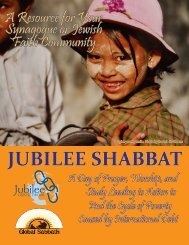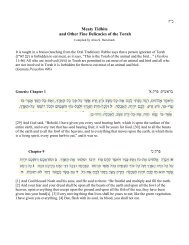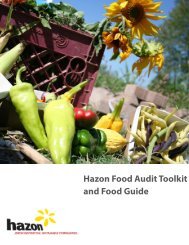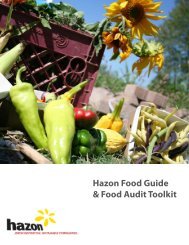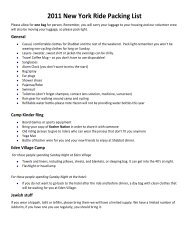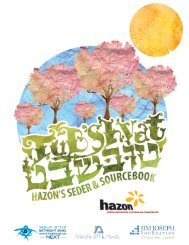1 Honey Tasting: Introduction A taste of honey can began a ... - Hazon
1 Honey Tasting: Introduction A taste of honey can began a ... - Hazon
1 Honey Tasting: Introduction A taste of honey can began a ... - Hazon
Create successful ePaper yourself
Turn your PDF publications into a flip-book with our unique Google optimized e-Paper software.
<strong>Honey</strong> <strong>Tasting</strong>:<br />
<strong>Introduction</strong><br />
A <strong>taste</strong> <strong>of</strong> <strong>honey</strong> <strong>can</strong> <strong>began</strong> a story (or unit) about fascinating insects, the<br />
importance <strong>of</strong> pollinators for our own food supply as well as culinary and<br />
other history, environmentalism and more.<br />
<strong>Honey</strong> is created when bees collect plant nectar from flowers transform it,<br />
with enzymes from their own bodies, into a stable carbohydrate and mineral<br />
rich product. <strong>Honey</strong>bees make <strong>honey</strong> to feed themselves and their hive<br />
mates. Enterprising humans have figured out, over the millennia, many<br />
ways to “harvest” this delicious crop. The color and flavor <strong>of</strong> <strong>honey</strong> is<br />
influenced by many factors, including the location <strong>of</strong> the hive, the available<br />
floral sources and climatic conditions. Even a hive in the same spot will yield<br />
a varied selection <strong>of</strong> <strong>honey</strong>s over the course <strong>of</strong> a summer.<br />
<strong>Honey</strong> is also one <strong>of</strong> the oldest foods and was common in ancient Egypt as<br />
well as being mentioned in the Bible and Qur'an. If harvested correctly,<br />
<strong>honey</strong> almost never spoils: an edible jar <strong>of</strong> <strong>honey</strong> was found in an Egyptian<br />
Pharaoh’s tomb. Lately, new research into its antibacterial and anti-fungal<br />
properties including <strong>honey</strong> as the treatment <strong>of</strong> choice for some burns and<br />
wounds.<br />
…Has the texture <strong>of</strong> s<strong>of</strong>t lemon curd. Floral aromas <strong>of</strong> spring hedgerows, straw bales and<br />
wildflowers. Smooth and intense flavors, with notes <strong>of</strong> <strong>honey</strong>suckle and caramel<br />
Pale gold in color and deliciously syrupy. S<strong>of</strong>t floral aromas with hints <strong>of</strong> the seaside.<br />
Pale beige color, aroma varies from sweet floral to deep, slightly earthy tones. Very floral flavor,<br />
though not too sweet, with hints <strong>of</strong> vanilla and spice…<br />
A lesson from Save the Bees – a interdisciplinary thematic unit on <strong>honey</strong>bees, by Anna Herman, 2010, for more<br />
information about this work, contact Anna @ foodowork@aol.com<br />
1
HONEY TASTING<br />
Objective:<br />
To develop a vocabulary and experience with sensory inquiry by comparing<br />
and contrasting several varieties <strong>of</strong> <strong>honey</strong>.<br />
Secondary objective is to interest and excite students to want to explore and<br />
learn more about the fascinating insects that make this amazing product.<br />
Additional objectives might be as part <strong>of</strong> a unit or discussion about food<br />
webs, local foods, Rosh Hashanah, the physiology <strong>of</strong> <strong>taste</strong> etc.<br />
Supplies:<br />
More than one type <strong>of</strong> <strong>honey</strong>. Try to find at least three. There are many<br />
many combinations you could <strong>of</strong>fer. Try to select <strong>honey</strong>s that appear<br />
different – in color, in opacity, in thin vs. crystallized or with comb and<br />
without. The more variety the easier it is for younger students to compare.<br />
Sometimes I just <strong>of</strong>fer <strong>honey</strong> from different frames in one hive – which<br />
represent <strong>honey</strong> from early spring and from mid-summer. Even though<br />
made by the same bees weeks apart the <strong>honey</strong> looks and <strong>taste</strong>s dramatically<br />
different. Find a local beekeeper, through a farm market or local bee<br />
association, purchase <strong>honey</strong> on trips and compare Vermont to New York or<br />
Paris to Philadelphia etc.<br />
Other supplies – could include <strong>honey</strong> in the comb, herbs or flowers or<br />
fragrant woody branches or fruits to “scratch and sniff”<br />
Set up:<br />
Have several jars <strong>of</strong> <strong>honey</strong>, small plastic spoons or popsicle sticks.<br />
Ask or remind students about the five senses. Seeing, Hearing, Touching,<br />
<strong>Tasting</strong>, Smelling<br />
First: Color, Clarity - Seeing<br />
(ask your students to) observe and note:<br />
Is the <strong>honey</strong> light, amber, dark brown, opaque, clear, transparent ?<br />
Second: Aroma – Smelling<br />
Offer a sniff <strong>of</strong> each <strong>of</strong> the jars<br />
(ask students to) observe and note:<br />
A lesson from Save the Bees – a interdisciplinary thematic unit on <strong>honey</strong>bees, by Anna Herman, 2010, for more<br />
information about this work, contact Anna @ foodowork@aol.com<br />
2
Is the aroma fresh, floral, herbaceous, fruity, pleasing, strong?<br />
Are there other things this <strong>honey</strong> reminds you <strong>of</strong>….forests or fields, grass,<br />
flowers, animals, berries etc.<br />
Individuals or small groups <strong>can</strong> jot down their descriptive words for each<br />
different <strong>honey</strong>, and preferences or other opinions<br />
Third/Fourth: Flavor and Texture: <strong>Tasting</strong> & Touching –<br />
Take/<strong>of</strong>fer a small spoonful <strong>of</strong> <strong>honey</strong><br />
What is the texture (touch) – smooth, thin, runny, thick, gritty - or some<br />
combination?<br />
Can you describe the flavor? Is the <strong>honey</strong> sweet (<strong>of</strong> course!), are there any<br />
obvious flavors that jump right out. Is there any bitterness, herbaceous -<br />
ness (herb like qualities), what about floral or wood notes, herbs,<br />
caramel, balsam, leather, cream, cheese, smoke, fruits, berries, etc.<br />
Individuals or small groups <strong>can</strong> jot down their descriptive words for each<br />
different <strong>honey</strong>, and preferences or other opinions<br />
Hearing – this is a sense that is not really involved in this lesson, though<br />
the sound <strong>of</strong> slurping as students <strong>taste</strong>, and the comments one overhears<br />
<strong>can</strong> influence your experience<br />
If there is an observation hive as part <strong>of</strong> your lesson – you <strong>can</strong> ask students<br />
to listen to the bees…observation hives provide endless learning<br />
opportunities….the sounds from the hive vary seasonally and <strong>can</strong> indicate<br />
overall “disposition” <strong>of</strong> the hive.<br />
As a summary leaders <strong>can</strong> create a master list <strong>of</strong> all the descriptive<br />
words and see where there are similarities and differences <strong>of</strong> opinions<br />
amidst the group. Students discuss and determine agreement or not<br />
on the traits <strong>of</strong> each <strong>honey</strong>. Students <strong>can</strong> <strong>taste</strong> again after hearing<br />
some <strong>of</strong> the descriptive words and see if they <strong>can</strong> now find the aromas<br />
or flavors that others have noticed. This interactive opportunity <strong>can</strong><br />
heighten students awareness and help them to develop their<br />
confidence in tasting and describing <strong>taste</strong>s, as well as evaluating<br />
flavors and aromas. It is fun to try this again another day with the<br />
same <strong>honey</strong> selection and see what <strong>taste</strong> memories are revived.<br />
Let me know what other sorts <strong>of</strong> directions you go with this idea…<br />
A lesson from Save the Bees – a interdisciplinary thematic unit on <strong>honey</strong>bees, by Anna Herman, 2010, for more<br />
information about this work, contact Anna @ foodowork@aol.com<br />
3


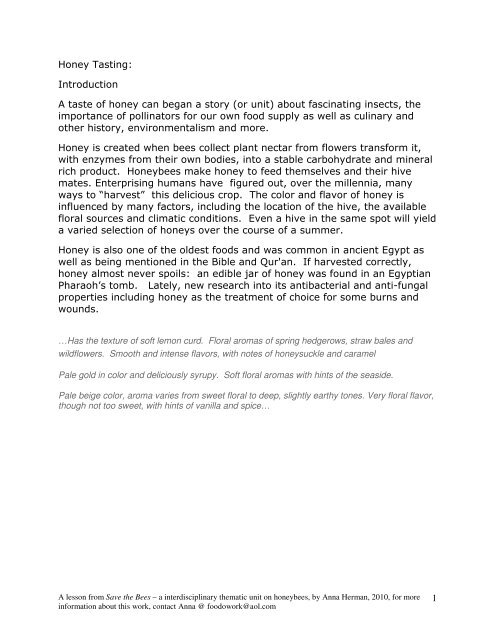
![2011 Israel Sustainable Food Tour Schedule [PDF]. - Hazon](https://img.yumpu.com/50366185/1/190x245/2011-israel-sustainable-food-tour-schedule-pdf-hazon.jpg?quality=85)
